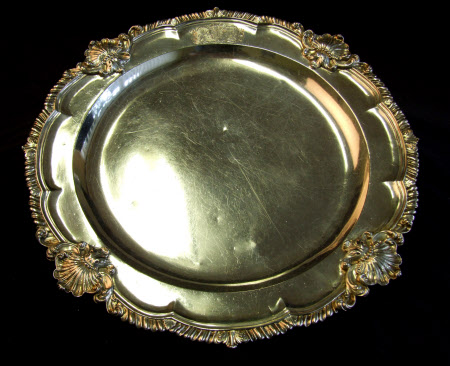Four round dishes
probably Frederick Kandler
Category
Silver
Date
circa 1751
Materials
Silver
Measurements
2.2 cm (Height); 32.4 cm (Diameter)
Place of origin
London
Order this imageCollection
Ickworth, Suffolk
NT 852121.3
Summary
Four round dishes, silver, probably by Frederick Kandler, London, circa 1751. These dishes, which were formed out of earlier pieces, are associated with the dish covers of circa 1758 (NT 852121.1) Each dish is raised with a shallow circular well, a broad rim and a cast shaped border with twelve gadrooned lobes, each group of three having a central acanthus leaf. At four of the intersections between the lobes are cast scallop shells with pearl bands and flanking foliate scrolls. Heraldry: The rim of each dish is engraved with the quartered shield, supporters and motto of the 2nd Earl of Bristol in an ermine mantling and beneath an earl’s coronet.
Full description
As with Ickworth’s large oval dishes (NT 852080), sauce boats (NT 852082) and salad dishes (NT 852062), these dishes have cast shells to unite them with the rest of the service. The borders, which are particularly finely modelled, derive from those which emerged in the mid 1740s and were most spectacularly employed on the Leinster dinner service supplied by George Wickes in 1747, though in that case combined with reeding rather than gadrooning.[1] From the evidence of the hallmarks (two without any and two with those of former pieces) and scratchweights, plus slight differences in the engraving of the arms, these four dishes represent the combination of two separate sets, so there may well have been eight originally, supplied in two batches. Although often referred to as ‘second course dishes’ such a term seems only rarely to have been applied in the mid eighteenth century [2] and they would have been able to be used with the first, second or third courses, all of which needed subsidiary dishes, or hors d’oeuvres, on the table around the principal fare.[3] Hors d’oeuvres were described by Louis Liger in his 1711 publication, Les ménage des champs et le jardinier françois as being served ‘aux trois premiers services’ [4] and examples given by Vincent La Chapelle in 1736 for ‘a Supper of 15 or 16 Covers’ included ‘Mutton-Cutlets glaz’d with Endive’, ‘Larks the Moscovite way’ and ‘Fillets of Soles with Champain’.[5] As with the London-made plates (NT 852124), scientific analysis has confirmed that the body of the dish sampled (no. 1) is Britannia standard and the border sterling.[6] This piece also has an old setting-out mark well off the current centre which suggests a previous existence as a much larger dish. The 1st Earl does not record any silver purchases in 1712–13, the date of the hallmark, but that year does coincide with both Carr Hervey’s return from three years abroad and his coming of age, so the dish could have been his. Alternatively it could have formed part of the plate acquired from the estate of Lady Howard of Effingham in 1727,[7] as might the surviving salver by Robert Cooper, made the same year and subsequently owned by the Hon. Felton Hervey.[8] James Rothwell, Decorative Arts Curator February 2021 [Adapted from James Rothwell, Silver for Entertaining: The Ickworth Collection, London 2017, cat. 36, p. 117.] Notes: [1] Elaine Barr, George Wickes, 1980, pp. 197-205, ill. [2] Three dishes of 1759 at Temple Newsam by William Reynolds or Reynoldson have been inscribed ‘2nd course’ on their undersides, probably contemporaneously. See James Lomax, British Silver at Temple Newsam and Lotherton Hall, 1992, cat. 85, pp. 94-5. I am grateful to the author for alerting me to this example. [3] Barbara Ketcham Wheaton, Savoring the Past, 1983, p. 140. [4] Marie-France Noël-Waldteuffel, ‘Manger à la cour: alimentation et gastronomie aux XVIIe et XVIIIe siècles’, in Versailles et les tables royales en Europe XVIIème–XIXème siècles (Paris, 1993), p. 76. [5] Vincent La Chapelle, The Modern Cook, 1736, vol. 1, plate VII. [6] X-ray fluorescence (XRF) analysis carried out March 2015 on dish no. 1. The body is 96.94% silver and the border 95.71%. [7] Suffolk Record Office, 941/46/13, 1st Earl of Bristol’s diary and accounts 1688-1742. [8] Sotheby’s, 4 March 1965, lot 169.
Provenance
George Hervey, 2nd Earl of Bristol (1721-75); by descent to the 4th Marquess of Bristol (1863-1951); accepted by the Treasury in lieu of death duties in 1956 and transferred to the National Trust.
Credit line
Ickworth, the Bristol Collection (National Trust)
Makers and roles
probably Frederick Kandler, goldsmith
